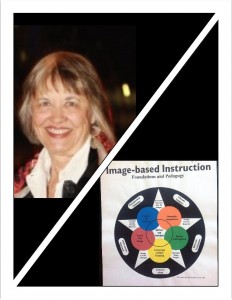Q OliveAnn Slotta: What is the current practice of Imaginal Education in the classroom?
Oliveann Slotta: I edited a book on Imaginal Education to try to answer that exact question: Image-based Instruction – Foundations and Pedagogy was designed so that anyone, [even someone not specifically trained in Imaginal Education could teach using one or more of the methods.
The book is really a workbook or manual – it has all the charts, handouts, lecture notes that anyone would need to get started using basic immaginal education tools.
-
Chapter 1 describes and analyzes Kenneth Boulding’s “theory of knowledge” and applies it to address individual students’ mental models toward improved motivation and attention. Specifically, Boulding theorizes on how a student’s images effect his or her behaviour and how changed images make a substantial difference (see The Image.)
Chapter 2 features the ICA’s “Conversation Method” of designing an intentional conversation flow with any group of students using a carefully crafted sequence of questions. An acronym for the question flow is conveniently referred to as “ORID” which stands for Objective, Reflective, Interpretive, and Decisional level questions.
Chapter 3, my personal favorite! It empowers my daily teaching, and is the ultimate Curriculum Design model. This is a wholistic system of designing curriculum using a three-part “symphony” image to plan curriculum for any period of time, whether an entire unit or a daily lesson. The product of this approach is a pallet of objectives—both measurable and experiential—as well as learning activities, which results in scripted notes to guide both classroom presentations and future planning. This chapter also shares the Kaleidoscope symbol, featuring fifteen different aspects of carefully planned curriculum that can be used by the teacher or professor to prompt her or his planning to be learner-centered and to ultimately “Reveal the Wonder” of learning.
Chapter 4 shares the image of a Community of Practice about how you might apply a collaborative method of teachers working together as learning facilitators.
Elsewhere in the blog are chapters that discuss current education themes, such as “Flipped Lessons“ where students are given the lecture on video as homework, then the teacher/professor spends more time answering follow-up questions, mentoring individual students and coaching small working groups doing “project-based inquiry”
Want to keep track of our progress? Click the “Subscribe” button.

Thank you for including me in this process. This work is timely for the passing of the “no child left untested” era.
The progress looks good, considering all that has been accomplished already!
Thank you for keeping me “in” the loop on this process.
Evelyn Philbrook
Hi Evelyn
You are welcome
Hope to have more “loops” when the book gets published!
Steve Harrington
Great work Oliveanne, Thanks for the work. Look forward to you being part of our CoP Education conversations and sharing practical support and best practice.